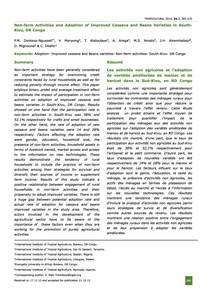| dc.contributor.author | Dontsop Nguezet, Paul M. |
| dc.contributor.author | Manyong, Victor M. |
| dc.contributor.author | Abdoulaye, Tahirou |
| dc.contributor.author | Alene, A. |
| dc.contributor.author | Amato, M.S. |
| dc.contributor.author | Ainembabazi, John H. |
| dc.contributor.author | Mignouna, Djana B. |
| dc.contributor.author | Okafor, C. |
| dc.date.accessioned | 2019-12-04T11:04:07Z |
| dc.date.available | 2019-12-04T11:04:07Z |
| dc.date.issued | 2016 |
| dc.identifier.citation | Dontsop-Nguezet, P.M., Manyong, V., Abdoulaye, T., Arega, A., Amato, M.S., Ainembabazi, J.H.,.... & Okafor, C. (2016). Non-farm activities and adoption of improved cassava and beans varieties in South-Kivu, DR Congo. Tropicultura, 34(3): 262-275. |
| dc.identifier.issn | 0771-3312 |
| dc.identifier.uri | https://hdl.handle.net/20.500.12478/1345 |
| dc.description | Open Access Journal |
| dc.description.abstract | Non-farm activities have been generally considered as important strategy for overcoming credit constraints faced by rural households as well as for reducing poverty through income effect. This paper employs binary probit and average treatment effect to estimate the impact of participation in non-farm activities on adoption of improved cassava and beans varieties in South-Kivu, DR Congo. Results showed on one hand that the participation rate in non-farm activities in South-Kivu was 38% and 52.1% respectively for crafts and small businesses. On the other hand, the rate of adoption of new cassava and beans varieties were 14 and 28% respectively. Factors affecting the adoption rate were gender, education, household size, the presence of non-farm activities, household assets in terms of livestock owned, market access and access to the information on new technologies. These results demonstrate the tendency of rural households to include the practice of non-farm activities among their strategies for survival and diversify their sources of income or supplement farm income. Results of this study indicate a positive relationship between engagement of rural households in non-farm activities and their propensity to adopt improved varieties. There is still a huge gap between potential adoption rate and actual rate of adoption for cassava and beans improved varieties in the study area. Therefore, actors involved in the development of the agricultural sector have to be aware of the importance of these factors even when they are working for the promotion of purely agricultural activities. |
| dc.description.sponsorship | Directorate-General for Development Cooperation and Humanitarian Aid, Belgium |
| dc.format.extent | 262-275 |
| dc.language.iso | en |
| dc.subject | Non-Farm Activities |
| dc.subject | Improved Cassava Varieties |
| dc.subject | Improved Beans Varieties |
| dc.subject | South Kivu |
| dc.subject | Democratic Republic Of The Congo |
| dc.title | Non-farm activities and adoption of improved cassava and beans varieties in South-Kivu, DR Congo |
| dc.type | Journal Article |
| dc.description.version | Peer Review |
| cg.contributor.crp | Roots, Tubers and Bananas |
| cg.contributor.affiliation | International Institute of Tropical Agriculture |
| cg.contributor.affiliation | Evangelic University in Africa |
| cg.coverage.region | Africa |
| cg.coverage.region | Central Africa |
| cg.coverage.country | Congo, Dr |
| cg.isijournal | ISI Journal |
| cg.authorship.types | CGIAR and developing country institute |
| cg.iitasubject | Biofortification |
| cg.iitasubject | Cassava |
| cg.journal | Tropicultura |
| cg.howpublished | Formally Published |
| cg.accessibilitystatus | Open Access |
| local.dspaceid | 79330 |
| cg.targetaudience | Scientists |

